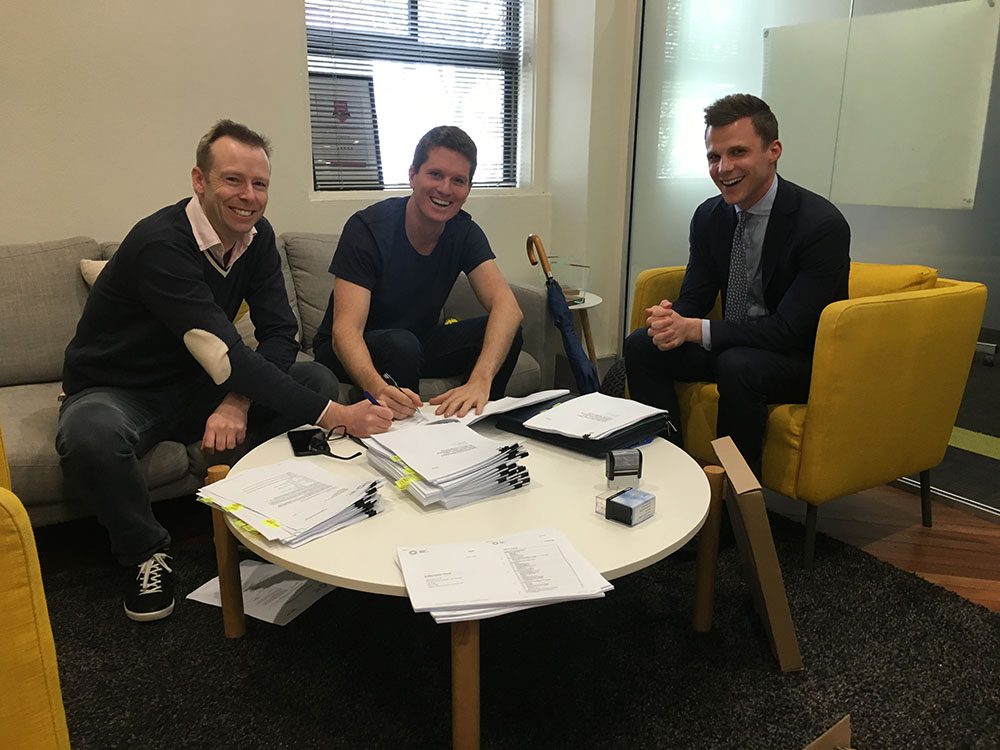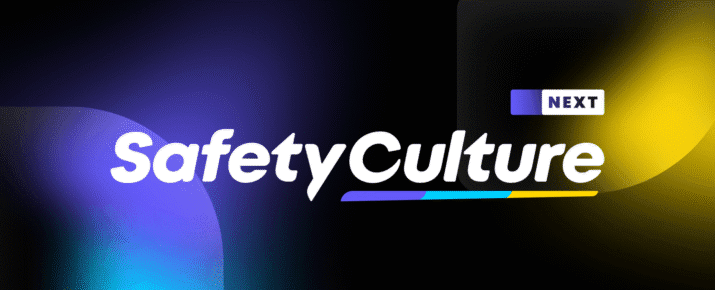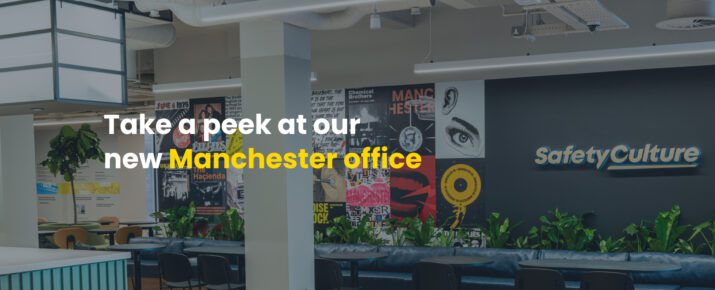How A Terrible Pitch Landed $23m In Funding
SafetyCulture News | By | 17 Oct 2016 | 5 minute read

 (Left to Right) Rick Baker from Blackbird, yours truly and Tom Hoare from Herbert Smith Freehills as we sign the mountain of investor documents.
(Left to Right) Rick Baker from Blackbird, yours truly and Tom Hoare from Herbert Smith Freehills as we sign the mountain of investor documents.I am sitting in Mayfair, London in a glass office with a pale timber floor. There is a DeLorean parked out on the street. The same kind of car from Back to the Future. The walls are white and the office has no smell, it is immaculately clean. It’s almost as if it is designed to not offend anyone. There is no one thing that you could not like about it. At the same time, there is no opulence, no extravagance. It is just a very nice, modern, spacious and clean office, and I have just made the biggest decision of my life. I agreed to accept $23m USD in funding, led by the Venture Capital firm, Index Ventures.
 The DeLorean that was parked out front. With Russian number plates, I don’t think they are paying the fine on the windscreen.
The DeLorean that was parked out front. With Russian number plates, I don’t think they are paying the fine on the windscreen.Thirty minutes ago, I was sitting at the 20 seat marble board room table, delivering one of the worst explanations of what SafetyCulture has done that I’ve ever delivered. I had to prepare a pitch deck for the presentation. I don’t like pitch decks, they are too slick and miss the crust of the real challenge we face each day. I had put this one together in the days before this meeting. The more I talked through it, the dryer and less energised I felt. I don’t like presenting. I enjoy conversations, but this wasn’t a conversation, it was a presentation. It was something that was somewhat rehearsed, and anything rehearsed isn’t a conversation, it is a preconceived delivery that is supposed to lead someone to an outcome. That is what bothers me about pitches. I don’t want to lead someone to an outcome – that is selling. I want to allow someone to reach their own conclusion about what this is. I don’t want to sell, I want them to buy. If what we are doing doesn’t resonate at a deep level, then they are not the investors for us.
In all there was maybe 12–15 people made up of partners and analysts who were some of the most credentialed people I’d ever been in the company of. Four were via video in San Francisco, including Mike Volpi, former world number 2 of Cisco. There were two cameras on my right, and there were people on my left, I didn’t know which way to look. Mike Volpi, former chief strategy officer of Cisco; Danny Rimer, founding partner of Index Ventures; Ilya Fushman, former head of product at Dropbox; and other intelligent, kind people who had given up their time to hear my thoughts about the future of safety and quality in the workplace.
I felt like I was dying in slow motion. I spoke for 30 minutes oscillating from the people on my right in the video, to the people on my left in the room and back again. After the presentation, I was asked questions for 30 minutes. But instead of listening to the question, I was punishing myself for what I had just said, and thinking up how I should have said it better.
After I finished answering the questions, the room fell silent, I said thank you and I walked out along with Jan Hammer, who was the sponsoring partner who had arranged the meeting. Jan walked with me back to his office and I had no sense of how much time had just passed. He said that the presentation was great and complimented me on the fact that the timing was perfect. It had been exactly 60 minutes. I felt he was being too kind.
Jan said he would debrief with his partners and come back to me shortly. I felt terrible. I had flown 30 hours from Australia to London for this meeting, and was flying back again the same day I arrived. I was kicking myself for such a bad pitch and getting caught up in fundraising, when we should have just been focused on building our company.
2.5 years earlier we had lit a fuse, the day when we accepted our first venture capital funding from Rick Baker at Blackbird in Sydney. Rick walked into my garage and believed in what a few guys were doing.
We had accepted $6m USD only 7 months earlier from Australian investors, and we had cash in the bank, but I have learnt that all of our projects, cost more money that we expect, and it takes longer than we anticipate to achieve our goals. So in the back of my mind, I knew that instead of aiming to be profitable in six months, we would continue to build out our team and scale the company, which would mean at some point we would need more cash.
Back in Australia, we were being approached by investors every week and I would usually not engage with them as it becomes too distracting, but occasionally I would take a meeting in order to build a relationship. The problem with speaking with them, is that then they would often want to invest.
Investors want to buy a great company as early (cheaply) as possible, in order to see the greatest gain. As a founder and CEO, I don’t want to release any of our equity unless it helps us achieve our long term goals as a company. Therein lies the dichotomy between investors and founders with a long term vision.
Sitting in Jan’s office waiting for a decision from the investment committee, I just wanted to pack up my laptop and leave before the bad news is delivered. I thought about waiting downstairs in a cafe so I was out of view of the office staff who could no doubt see that I was looking deflated and wanted to climb the walls to get out. I was convinced that they were not going to invest and I just wanted to get back to the team and get on our mission.
Twenty minutes or so later, Jan walks in, gives me a high five and says it’s approved, everyone voted in favour of the investment. I couldn’t believe it. I said, “You cannot be serious? That was not a good pitch.” But apparently, the team could see the vision, and along with their prior due diligence and their trip to meet our team in Australia, it was good enough. We spent the next 30 minutes nutting it out and just like that, the story of SafetyCulture just moved into a new chapter.
That emotional roller coaster was a condensed version of the high octane, adrenaline ride that founding a tech company feels like everyday. You never really know for sure if what you are doing is the right thing, but you have to keep moving forward.
The responsibility I feel now to solve the problem of workplace safety and quality is greater than ever. Our team has to deliver on the mission we have set out to achieve. I feel that responsibility everyday, I worry that we are investing in the wrong areas, or that we are not investing enough in the right areas. I worry that we don’t have the right people, that we have too many people and other times that we don’t have enough people. But as time goes by, and my experience grows, I come to learn that, I’m never 100% certain of the right way, I just need to keep pushing myself and our team to grow and be better at what we do every day in order to complete our mission.
By the time you are reading this, the long docs (as we say in the biz) would have been completed by the lawyers and I am about about to announce to the world that SafetyCulture has completed our largest funding round to date. I will announce that we are going through the next stage of growth and spread the word, that we are looking for the most talented people we can find who want to join us on our mission.
5,760 people die everyday from workplace incidents and illnesses. Our products help people avoid those incidents and everyday we are getting a little closer to delivering on our promise.
Important Notice
The information contained in this article is general in nature and you should consider whether the information is appropriate to your specific needs. Legal and other matters referred to in this article are based on our interpretation of laws existing at the time and should not be relied on in place of professional advice. We are not responsible for the content of any site owned by a third party that may be linked to this article. SafetyCulture disclaims all liability (except for any liability which by law cannot be excluded) for any error, inaccuracy, or omission from the information contained in this article, any site linked to this article, and any loss or damage suffered by any person directly or indirectly through relying on this information.





